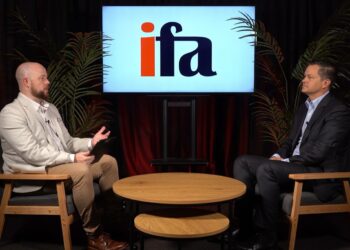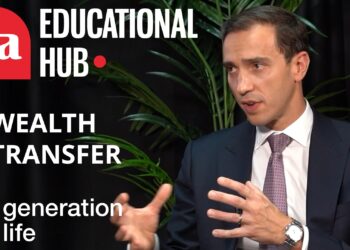Allianz Retire+ head of product and customer experience Jacqui Lennon discusses how advisers and retiree clients can navigate the unique challenges of today’s retirement investment market.
ifa explores the important issues impacting on the Australian financial planning and wealth management industries. Watch the full video here.
– Full Transcript –
Sarah Kendell: With interest rates both at home and around the world likely to remain at this ultra-low level for some time, what does this mean for retiree portfolios?
Jacqui Lennon: Well despite what most retirees think it means cash is not king any longer, because you’re not going to be able to generate sufficient returns out of a cash portfolio.
Back in the good old days, we used to be able to construct a portfolio that was sort of 60:40, and that would give you lovely returns of 7.5 per cent with a nice small standard deviation. But these days to generate that 7.5 per cent return, you’re going to need a portfolio that’s 96 per cent growth assets. So you’re going to have to go crazy on the growth assets to really replace some of those high-yielding defensive assets. So really what it means in interest rate environments, where they’re so low, is that retirees really need to look for alternative investments.
To generate that 7.5% return, you’re going to need a portfolio that’s 96% growth assets.
Sarah Kendell: If you’re talking about the fact that sort of 60:40 can’t really be the classic insurance policy that it once was, do retiree clients also need to worry about over-allocating to growth or high risk assets?
Jacqui Lennon: Yeah. Unfortunately for retirees, they are really stuck here. So they can’t go to defensive cause we know that’s not going to generate return, so they need to move into growth assets. But those people in the early stages of retirement are really susceptible to sequencing risk or basically the risk that the share market would drop early in their retirement. And we know that if you have a negative impact on your share portfolio early in your retirement, you’re never going to recover, your retirement will be different forever more. So while we’ve got these retirees who are moving out of cash into growth assets, they really need to be thinking about this sequencing risk and really trying to work out how to mitigate that risk and their now more growth-oriented portfolio. The other problem that retirees have, is that the pain of watching their portfolio go down is far more extreme in retirement than it is in that accumulation stage.
So we know most people like you and I are still in accumulation stage. We feel the pain of a loss twice as much as we feel the joy of the gain. But once you get to retirement and you know that there’s no more money coming into that pot, you start feeling that pain a lot more. In fact, it flies out to about ten times. So retirees are feeling that pain, that loss ten times more than they feel the joy of a gain. Sitting there and watching their portfolio go down is an extremely upsetting event for them. It’s a really tough time, particularly in a global pandemic to be thinking about constructing appropriate retirement portfolios, that are going to give the return, but feel okay for the retiree as well.
Sarah Kendell: I’m going to ask about that emotional aspect of things in terms of the behavioural factors in an investment market, like the one that we’re currently sort of experiencing. How can advisors work with retiree clients to make sure that they avoid making costly mistakes from an emotional decision?
Jacqui Lennon: A friend of mine who works in an industry fund, Tommy, could pick the top of the market and the bottom of the market. He said it was really easy. You could pick the top of the market because that was the point whenever people moved out of cash and into shares, and you could pick the bottom of the market because that was the point when you had the most number of people moving out of shares and into cash. So unfortunately we’re terrible at reading the timing of the markets. And we know that retirees also have this pain and that loss so you’re starting to see that when you’re getting market volatility. They’re making really short-term knee-jerk reactions and moving all their money out of shares into cash and not staying there for the longer term. Now you really need to be there in the longer term to get the benefit of the shares and those growth assets.
From an adviser’s perspective, some of the sorts of things that they could actually do, is when they’re moving retirees into a growth portfolio, really talk about volatility and assess how they’re going to feel about the share market going up and down. When it does happen I know lots of advisors are really great at talking their clients through, calming them down, trying to move them away from their instinctive reaction which is ‘sell, sell, sell, get me out of this’.
And then in a really extreme example, which I haven’t seen many of advisers adopt, but I would recommend it for some clients, is actually removing some of the access to check their balances all the time. Retirees are in the situation where they’ve got lots of free time. And when I go and talk to retirees, often, they’ll tell me that they go in and check the balance daily, weekly, frequently. One of the guys was telling me that even though the balance doesn’t change during the day, because it only prices overnight, he would still go in multiple times during the day to look at his balance. These people are feeling really freaked out and they make terrible decisions. So if you could actually remove some of their access and tell them not to check it, I think that would be a bold, but really useful way to help retirees reduce some of that tension and that emotional upset that they have when they see their portfolios moving around so much.
Sarah Kendell: Absolutely. It’s the opposite of the accumulation investor, who they need to be more engaged, with a retiree, actually they need to be less engaged.
Jacqui Lennon: Exactly. You just want to calm it all down and stop looking. Hiding it away from you, I think is a good idea. It’s a dieting technique as well, right? Don’t put the chocolate at the front of the fridge, hide it away because you know, it’s not that useful for you. So I think we could learn a lot about that in terms of portfolio construction.
Sarah Kendall: And how about use of modelling as well? How can advisers use modelling to engage retiree clients about the future of their investments and different options that they might find?
Jacqui Lennon: Yes. It’s really important when an advisor is putting clients into growth portfolios, to be talking through the different range of returns or possible outcomes that may happen, and to get the client feeling comfortable with that. Because the last thing you want is a client experiencing shocks and surprises. Whether they’re good surprises or bad surprises – really, there’s no such thing as good surprises in this environment. So we’ve been really surprised, probably not surprised, but one of the challenges that advisers have is that many of the tools out there at the moment only allow them to do deterministic modelling. They really just model the average return to the average life expectancy.
And I think retirees would be surprised, but maybe horrified to realize that actually, the beautiful graphs that their adviser has given them well, there’s a 50 per cent chance that it’s going to be worse than that. And as we know, our retirees are conservative and they want to plan for worst-case events. So it’s disappointing that at the moment, advisers haven’t really been able to have rich conversations with retiree clients about the range of returns. So we’ve got a tool out there at the moment which allows people to simulate a whole range of return. So through stochastic modelling, you can see the range of returns about 50 per cent – so on average, where do you think you’ll end up, but then if you wanted to be more conservative and make sure that you would definitely going to have enough money to last through your lifetime. It allows you to model to the 90 per cent to 95 per cent of confidence.
And I actually think having that conversation with a retiree is really important, because when they can really see the trade-offs that they’re making in retirement and feel that sense of confidence, then they’re less likely to panic. And they’re less worried about things because they say on average, it’s good. But even in the worst case in 95 per cent, I’m still feeling confident that’s going to be good enough for me.
Sarah Kendall: Absolutely. Tell us a bit about the Allianz Retire+ Future Safe range and how it can help retiree clients to manage the current and recent challenges in the market.
Jacqui Lennon: So our product is designed specifically for retirees and it’s in our brand. And this product is really looking at that sequencing risk that I was talking about earlier. So it gives that great combination of access to market returns or access to growth assets, but also puts some protection into the product as well. The way it works is you can choose what level of protection you want, whether you want to have your maximum loss being minus 10 per cent, whether your maximum loss is minus 5 per cent or maximum loss is 0 per cent. Which gives you that sense if you can choose how comfortable you are because some people are more risk accepting than others. And then with each floor, that minus 10 per cent floor, you get an associated cap. The more risk you have in the bottom, the more upside you get at the top as well. And what we do is, we will credit to your account at the end of each year, whatever the market, the share market has delivered between your floor and your cap.
So you’re really getting that market-linked return and access to growth assets which we known is important that you’re getting that protection to avoid that sequencing risk, which we know can be so terrible in those early years at the time. So it’s a really great retirement solution that brings together the power of protection and growth into one solution. We think that’s something every retiree should be really considering in today’s environment, given where we are with the global pandemic and the interest rate environments we are going to be in for some time.
Follow us on:



